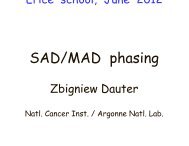Ligands in Coot
Ligands in Coot
Ligands in Coot
- No tags were found...
Create successful ePaper yourself
Turn your PDF publications into a flip-book with our unique Google optimized e-Paper software.
Model-Build<strong>in</strong>g Prote<strong>in</strong>s and<strong>Ligands</strong> us<strong>in</strong>g X-ray DataRecent Developments <strong>in</strong> <strong>Coot</strong>Paul EmsleyJune 2012
Modell<strong>in</strong>g Prote<strong>in</strong>s and<strong>Ligands</strong> with <strong>Coot</strong>pdf available on request/from John● Overview● New algorithms and features● Tools for Ligand-handl<strong>in</strong>g● Putt<strong>in</strong>g Tools for Invention <strong>in</strong> thehands of those collect<strong>in</strong>g the data● Modell<strong>in</strong>g Carbohydrates
Feature IntegrationRef<strong>in</strong>ementExternale.g. REFMACInternalInternalValidationExternale.g. MolProbityValidation, Model Build<strong>in</strong>g and Ref<strong>in</strong>ementshould be used together
Ref<strong>in</strong>ement TechniquesS<strong>in</strong>gle-Atom DragOver-dragg<strong>in</strong>gKey-b<strong>in</strong>d<strong>in</strong>gs:Triple Ref<strong>in</strong>eS<strong>in</strong>gle Residue Ref<strong>in</strong>e with Auto-acceptRamachandran Ref<strong>in</strong>ement
Usage Tips: Navigation(Type) Ctrl-G : → recentres on “G”: go to blob“P”: go to nearest atom (or CA if the residue if theresidue is a standard AA)“L” (unlabel) the atom at the screen centre“O” jump to other NCS cha<strong>in</strong>“V”: Undo symmetry view“Go To Ligand” (icon) → Jump to (next) ligand
Usage Tips: Use Keyb<strong>in</strong>d<strong>in</strong>gs(Noob → Pro)Built-<strong>in</strong>: “A”, “B”, “C”, “D” “F”, “Ctrl-Z”, “G”, “I”, “M”,“N”, “O”, “P”, “S”, “U”,“Ctrl-Z”, “”(My personal set): “Shift A”, “Shift B”, “E”, “Shift E”,“H”, “J”, “Shift J”, “K”, “Shift K”, “Shift M”, “Shift P”,“Q”, “Shift Q”, “R”, “Shift R”, “T”, “Shift T”, V”, “ShiftV”, “W”, “Shift W”, “X”, “Y”, “Shift 4”, “”,“(You can download these from the <strong>Coot</strong> Wiki)
Us<strong>in</strong>g NVIDIA CardsFor antialias<strong>in</strong>g:setenv __GL_FSAA_MODE nwhere n is 5 (or so)
Low ResolutionModel-Build<strong>in</strong>gRamachandran Optimization“Backrub” rotamers
Previous
To turn it on...(ROTAMERSEARCHLOWRES)
Network<strong>in</strong>g...PDBe <strong>in</strong>terface...Drag and dropAlso with drugbank19/80
PDBe Recent StructuresJSON parser, network threaded code
Us<strong>in</strong>g the API21/80
RCrane: Semi-AutomatedBuild<strong>in</strong>g of RNA
RCrane: Semi-AutomatedBuild<strong>in</strong>g of RNA
F<strong>in</strong>d<strong>in</strong>g HolesAn implementation ofSmart, Goodfellow & Wallace (1993)Biophysics Journal 65, 2455Atomic radii from AMBERI usedradii from CCP4 monomer librarysans simulated anneal<strong>in</strong>g
<strong>Ligands</strong> Tools <strong>in</strong> <strong>Coot</strong>“What should we make next?”Tools for drug discoveryParticularly fragment-based25/80
<strong>Ligands</strong> <strong>in</strong> <strong>Coot</strong>Import<strong>in</strong>g and build<strong>in</strong>g ligand from scratchPRODRG, LIBCHECK(Ligand Fitt<strong>in</strong>g)ValidationMogulRepresentationAnalysisBond ordersSurfacesMolprobity, LIDIA26/80
2D Ligand BuilderFree sketchSbase search
”Yesterday's” LigandCommon subgraph isomorphism, Kriss<strong>in</strong>el & Henrick (2004)Atom name match<strong>in</strong>gTorsion match<strong>in</strong>gLigand overlay
Cocktail Examples
Ligand ValidationCompare the observed structure to therestra<strong>in</strong>tsIn <strong>Coot</strong>: Validate → Geometry analysis
Parmatisation issues...(what if they are wrong?)Perfect ref<strong>in</strong>ement with <strong>in</strong>correct parameters →distorted structureCSD's MogulKnowledge-base of geometricparameters based on the CSDCan be run as a “batch job”Mean, median, mode,quartiles, Z-scores.
Ligand ValidationMogul plug<strong>in</strong> <strong>in</strong> <strong>Coot</strong>Run mogul, graphical display of resultsUpdate restra<strong>in</strong>ts (target and esds for bondsand angles)
Ligand RepresenationBond orders (from dictionary)
B<strong>in</strong>d<strong>in</strong>g mode analysisB<strong>in</strong>d<strong>in</strong>g site highlight<strong>in</strong>g,Isolated Molprobity probe dots
Chemical Features
Ligand OverlaysInclud<strong>in</strong>g maps, mean and varianceChemical Feature Cluster<strong>in</strong>g
Chiral Centre InversionInverted chiral centreref<strong>in</strong>ement pathologydetectionHydrogen tunnell<strong>in</strong>g
Ligand Environment Layout2d Ligand pocket layout (ligplot, poseview)Can we do better? - Interactivity?
Ligand Environment LayoutB<strong>in</strong>d<strong>in</strong>g pocket residuesInteractionsSolvent accessibilityhalosSolvent exclusion by ligandSubstitution contour
Solvent ExposureIdentification of solvent accessible atoms
Ligand Enviroment LayoutConsiderations2D placement and distances should reflect3D metrics (as much as possible)H-bonded residues should be close theatoms to which they are bondedResidues should not overlap the ligandResidues should not overlap each otherc.f. Clark & Labute (2007)(work <strong>in</strong> progress)
Layout Energy TermsResidues match 3DDistancesResidues don'toverlay each otherResidues are closeto H-bond<strong>in</strong>g ligandatomsResidues don'toverlap ligand
”Don't overlap the ligand”
Ligand Environment LayoutInitial residue placement
Optimis<strong>in</strong>g the m<strong>in</strong>imiser
Ligand Environment LayoutResidue position m<strong>in</strong>imisation
Determ<strong>in</strong>ation of theSubstitution Contour
Substitution Contour:Extend<strong>in</strong>g along Hydrogens
58/80
Layout Examples
Layout Problems
Layout Examples3uic
Layout Examples3uic
Layout Examplesrosiglitazone,4a7a
Layout Problems
Prote<strong>in</strong>-Prote<strong>in</strong> Interface LayoutMock-up!
Modell<strong>in</strong>g CarbohydratesValidation,Model-build<strong>in</strong>g,Ref<strong>in</strong>ement
Problematic Glycoprote<strong>in</strong>sCrisp<strong>in</strong>, Stuart & Jones (2007)NSB Correspondence“one third of entries conta<strong>in</strong> significant errors <strong>in</strong>carbohydrate stereochemistry...”“carbohydrate-specific build<strong>in</strong>g and validation toolscapable of guid<strong>in</strong>g and construction of biologicallyrelevant stereochemically accurate models shouldbe <strong>in</strong>tegrated <strong>in</strong>to popular crystallographicsoftware. Rigorous treatment of the structuralbiology of glycosylation can only enhance theanalysis of glycoprote<strong>in</strong>s and our understand<strong>in</strong>g oftheir function”PDB curators concur
Carbohydrate L<strong>in</strong>ksThomas Lütteke (2007)
Validate the L<strong>in</strong>ks
Ref<strong>in</strong>ement Trials(NAG-ASN example)
Model-Build<strong>in</strong>g
Technical Details
Acknowldegments,CollaboratorsBernhardLohkampKev<strong>in</strong>CowtanEugeneKriss<strong>in</strong>elStuartMcNicholasMart<strong>in</strong>NobleAlexeiVag<strong>in</strong>
AcknowledgementsKeith WilsonEleanor DodsonGarib MurshudovMax Crisp<strong>in</strong>Andrei LebedevLibraries, dictionariesAlexei Vag<strong>in</strong>Kev<strong>in</strong> CowtanEugene Kriss<strong>in</strong>elJane and Dave Richardson (Duke)Greg LandrumFund<strong>in</strong>gBBSRC &



